A 'How To' Do Local SEO Guide From SERPWoo

A Local SEO Guide From SERPWoo. Cheatsheet Included!
We won’t start this off by talking about why it’s crucial for businesses to be visible online, that’s been obvious since the last millennium. It’s a given that you want your business to show up in the search results, so we’ll get right into how to make that happen.
If you’ve had good results in the past and watched them slip away, this could be due to a shift towards an emphasis on local results. If you aren’t adapting and sending the right signals to search engines, you’ll have a hard time showing up above your local competitors.

Local SEO bridges the disconnect between the online world and your community. When someone’s looking for a local business, there is a high probability that they’ll soon drop by, especially if they’re searching for things like the address or the store’s hours.
This guide is very relevant for small businesses, local stores and shops of all types, and for online-based businesses as well. Thinking about local SEO is crucial if you’re doing local lead generation, or operating any type of local directory website, or even an online magazine or blog.
Even if your site isn’t based around local content, you are still from that place, and you can apply some of the tricks and strategies we’ll cover for local link building.
For businesses that do service a specific area, it’s simply not an option, you need to take steps to let the search engines know what’s up with your company.
Let’s take a look at what a local search result even looks like, and we’ll go over how to do a local SEO audit, how to see what your competitors are up to (and how to identify your competitors in the first place), how to avoid or fix common mistakes, how to measure your results, and more.
Looking at a Local SERP
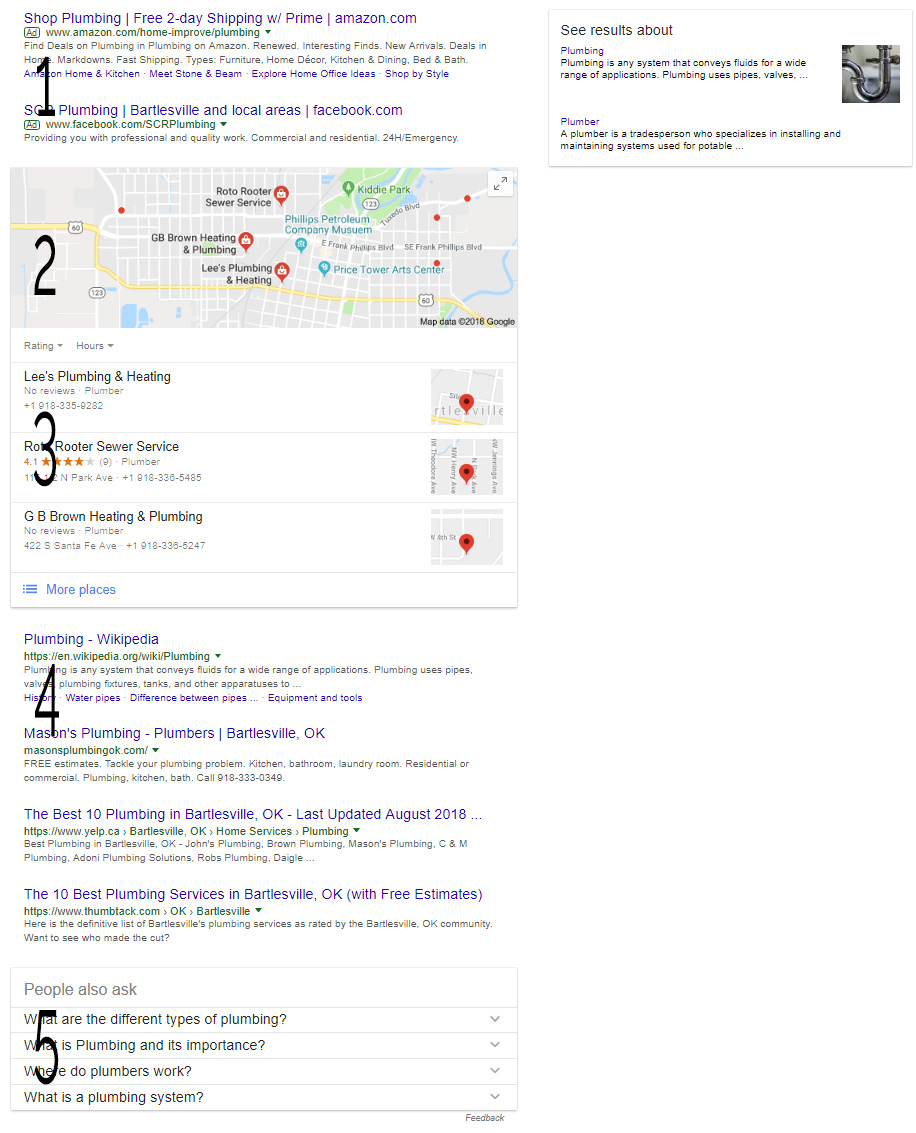
Google’s results pages for local search queries are different than the ones for standard searches.
- You’ll see a few ads at the top as usual. Paid traffic is your first opportunity to show up at the very top of a search result. Combined with all the other opportunities in a local SERP, there’s plenty of chances for you to be seen.
- Next up is the map that shows you the locations of the three businesses that are occupying the 3 Pack.
- The Infamous 3 Pack itself, your first non-paid opportunity to become visible in the SERPs.
- The organic top 10, which will have a mixture of broad and local results. Directories like Yelp that rank near the top should also be on your radar, you can create a listing there which will help by giving you a trustworthy citation. Also, a high placement on Yelp and similar sites means you’ll get a second opportunity to catch the attention of anyone who doesn’t notice you in the 3 Pack or the regular results.
- These can give you ideas for content that you can publish on your site. Below the “People also ask” box are another 6 search results not seen in this screenshot, and then some suggested searches which can also inspire content ideas for you.
Here’s a look at the before of local packs:
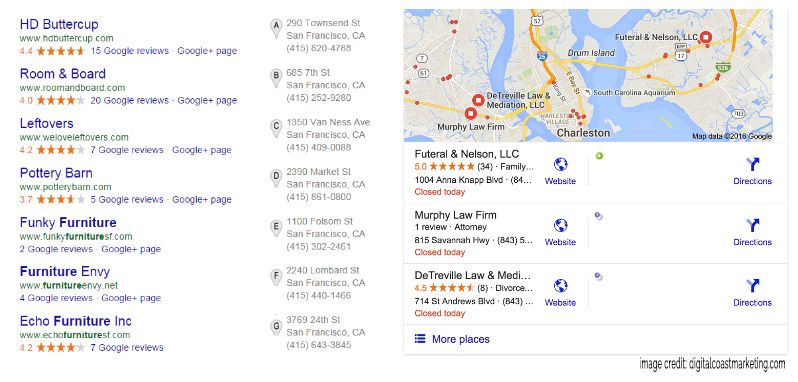
The look and style of the local pack has changed before and it will continue to change as Google tests and adapts their local results pages.
You can’t know for certain what will come next, but it’s relatively safe to assume that it will build on what they’re doing now, but you don’t want to rely entirely on any one thing for your business’ online success.
What if you focused all your efforts on the local pack, ignored the organic results, and the local pack disappears? Or changes dramatically?
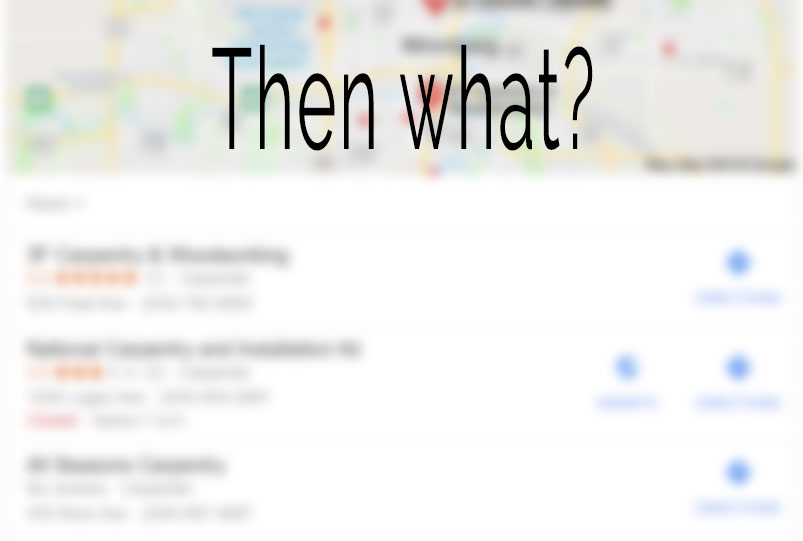
Ranking in the 3 Pack
Having your name, address, and phone number (NAP) cited around the web is the cornerstone of Local SEO.
Think of it as being like a backlink for Local SEO. Traditional backlinks are meant to signal trust by showing Google that your website is worth sending visitors to by having many other quality sites cosign for you. NAP listings work in a similar fashion when Google sees that your key info is consistent across many sources and that they can list it with a higher confidence.
Another important factor is to make sure that your site is mobile friendly, a lot of local searches are done on mobile devices and if your site has errors or offers a poor user experience, then getting those local mobile visitors will be like trying to ride roller blades through sand.
Finally, the elephant in the room is that these listings are location-based, but not just on a city level. In tests done in larger cities, people received different business recommendations in the 3 Pack when testing from different parts of town.

Don’t worry, if you aren’t reaching your whole service area and every potential client or customer in your city through the 3 Pack, there’s still the rest of the results
The Organic Search Results
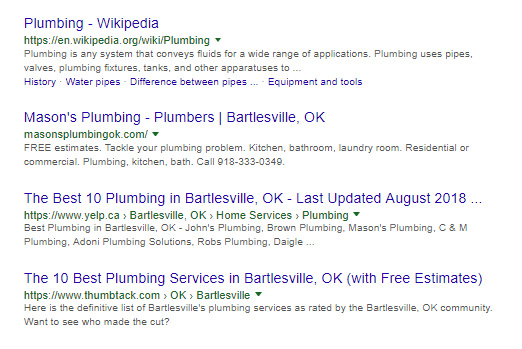
In the example above of the local SERPs for plumbing in Oklahoma, we’ve got Wikipedia in the top spot of the organic results, some directories, and additional local businesses listed below the “People also ask” box.
It’s not necessarily a bad thing when you see these directories, in this case Thumbtack and Yelp.
You can sign up, get your business listed there, and if you’re able to collect some positive reviews and fill out your profile, there’s a good chance you’ll earn a favorable position in their internal search results. This means that when somebody searches for “plumbing” (or whatever it is that you do) and they end up going to Yelp instead of your site, you’ve still got another chance to reach that person.
Ranking in Directories
Now we’ll go over some strategies to get good positions in directory-style and review sites. We’ll mainly be focusing on Yelp, but many of the same principles will apply across the board. There may be some subtle nuanced differences in how you fill out your profiles and listings, how you interact with the site, and what their terms of use are but they’ll be similar.
Ranking in Yelp
Yelp is a big one, they’ve got a stranglehold on many SERPs that go far beyond just restaurants.
From Lawyers, to Carpenters, to SEO agencies, you can find just about anything on Yelp.
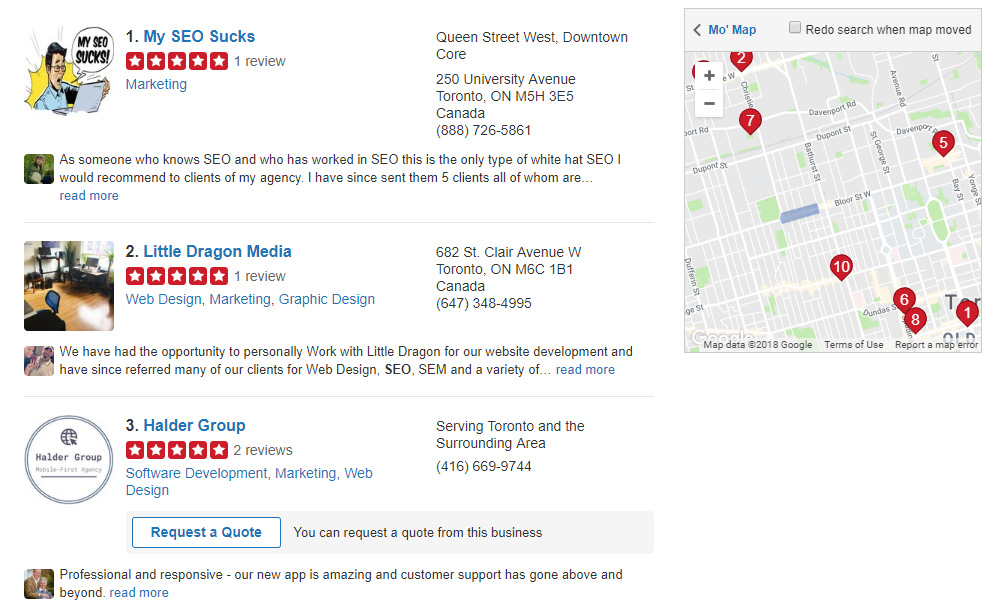
It can be a powerful ally, or a huge blight on your online reputation if you get hit with some negative reviews. A few bad reviews upfront can be a death sentence for a new business but getting a good placement in Yelp’s internal search results for a SERP that Yelp itself ranks highly can bring in a lot of customers, too.
So, how does Yelp’s algo work and how can you score a great spot?
Start by looking at some of the other businesses in your category and exploring their Yelp listings just to get a feel for how it should work, and what is working.
Next, you’ll want to come up with a handful of keywords that would be useful to include. We’ll go over keyword selection more in a few minutes, but for now you can stick with obvious things like your industry, “[profession] [city]”, and stuff like that.
It’s a bit different than the usual keyword research process since it’s mostly going to be long tails, in many cases they won’t show very many monthly searches at all, but those numbers aren’t gospel.
SERPWoo’s Keyword Finder can help you with this:

When you’re writing your descriptions in Yelp, be sure to pepper in a few of your keywords here and there.
Yelp offers Enhanced Profiles (which have been described as “extortion”) that are useful for some businesses, and a waste of money for others. An Enhanced Profile includes a call to action button, and Yelp says “Enhanced Profiles with a Call to Action button average a 33% increase in traffic and a 38% increase in customer leads vs. free profiles.”

If having a button on your pages leads to 33% more people visiting that page from the search results, one could make the connection that Yelp is giving preferential placements to Enhanced Profiles. Another factor could be that the types of businesses who opt for the Enhanced Profile are already taking Yelp seriously enough that they’d be getting more visitors regardless.
This expensive upgrade also gives you more control over your branding on Yelp, including more freedom for uploading photos and choosing which ones are highlighted. Enhanced Profiles prevent your competitor’s ads from showing up on your listing and allow you to include a video.
Are Enhanced Profiles worth it?
Whether or not the cost is worthwhile will depend on where you are and what you do. Yelp has a history of notoriously high advertising prices, with VentureBeat going as far as to call their $600 rate for 1000 impressions a rip-off back in 2012. You can reach out to Yelp’s advertising department to see what the damage would be for your business and location, but we’re more concerned with the local SEO aspects right now.

Once you’ve found some keywords and optimized your description and profile (Filling out all of the information including NAP), make sure you fill out the Specialty section of your profile too.
List your products, services, and everything you offer here.
Much Ado about Yelp Reviews
Reviews are very important, and an opportunity to get some natural keywords on your page.
Yelp strongly discourages you from asking for reviews, they go as far as to say that asking your happiest customers to review your business could hurt your reputation. It sounds like propaganda because they want to keep their reviews as natural as possible. Fair enough!
Yelp also has an algorithm that decides which reviews to recommend and which ones to suppress. They say it’s to hide fake reviews, and even to hide reviews that business owners have asked their customers to write. To take it a step further, they say: “our recommendation software is automated, the Yelp Support team cannot manually override the software to recommend or not recommend a review.”

They’re trying to filter out reviews left by your friends, or “unhelpful rants and raves.” If you have genuine reviews that you didn’t ask for that got caught up in this filter, your best bet is to reach out to the person who left it, thank them, and see if you can somehow encourage them to leave other reviews for other local businesses and to be a little more active on their account.
It could build up enough trust from Yelp to see them as a genuine person sharing their experience but it’s a long shot and there are more important things you could be focusing on to improve your local SEO.
Alternatives to Yelp
Yelp is a powerhouse and it’s a necessity to have at least a basic account, for the NAP and profile information if nothing else. Restaurants will want to think about going beyond that, Yelp ranks #1 for the massive keyword “Food near me” that gets searched millions of times per month, among countless others.
But there may be more fitting, industry-specific directories, or just other options out there that are also worth being listed in.
Here’s a quick look at a few, and you can find a list of citation sources sorted by Country here.

AngiesList.com still shows up in many “best [blank] in [city]” type of SERPs.

MerchantCircle.com helps you find local merchants in a variety of categories and offers businesses a chance to list themselves. They also offer a platform to syndicate your business listings across over 100 sites, and to update them all at once.

Manta.com offers business profiles and now also offers consulting on getting your business seen online, but you’re already accomplishing that on your own, so your best bet is just to grab the free profile.

BBB.org is still around, they’ve managed to transition from a pre-Internet world and to secure a footing in the digital one. Their clout is a lot bigger than their actual power, but customers still trust them. They have local directories which can be nice to show up in, but it’s not a make-or-break type of thing for your local SEO. It’s still a listing which furthers your trust with Google, along with a backlink to boot. Worth the fees? You’ll have to decide that on your own, but when it comes to local SEO, trust is very important, and the BBB has a lot of trust, for better or worse.
Performing a Local SEO Audit
We’ll be taking inventory of your current on-page SEO and various ranking factors that you can influence, and ensuring your site is setup to succeed.
These are mainly things that aren’t unique to local SEO, and we’ve already covered a lot of these optimization categories in our SEO Audit Guide, so we’ll just go over them briefly here as a refresher. You can find the complete SEO Audit checklist here.
Indexing Optimization:
If there’s a setting or a penalty or something else that’s stopping you from showing up correctly in Google, it’s important to identify that right out of the gates instead of having it hold you back.

This includes things like setting up Google Search Console for your site, making sure you’ve got a proper sitemap in place, seeing if your site has any existing penalties and taking steps to remove them, ensuring your canonical URLs are pointing to the right places, and the like.
In addition to the traditional SERPs, there are business listings that where you’ll want to be indexed, we’ll discuss that shortly in the NAP and Google My Business sections.
Performance Optimization:
Users like fast websites and so do search engines. There’s a good chance that a lot of your local competition won’t be too on the ball when it comes to page speed and performance, so this is one area where you can likely make up a lot of ground.
This includes checking how long it takes your site to load, setting up a CDN, optimizing your images to reduce their size, considering a faster hosting company, making sure your site scores high for mobile usability, and things like that.

Keyword Targeting Optimization:
It’s good to have a handle on which keywords you’re already ranking for, and which ones you’re close to ranking for that just need a little extra attention.
The obvious keywords to consider for local SEO are things like your own business name, your industry or profession, and what you offer in terms or products or services.
Content Optimization:
This is just to ensure that you don’t have 404’s, that you don’t have orphaned pages with no inner links pointing to them, that your URL’s are making use of your keywords, that you’re using header tags efficiently, that you’re using markup to structure your on-page data, and so on.

Another aspect of this is creating locally-relevant content to give you a better position in the organic search results that appear below the Local 3 Pack.
External Optimization:
For regular SEO, this would cover things like keeping up a disavow list, keeping an eye out for scrapers stealing your content, and looking at inbound links.
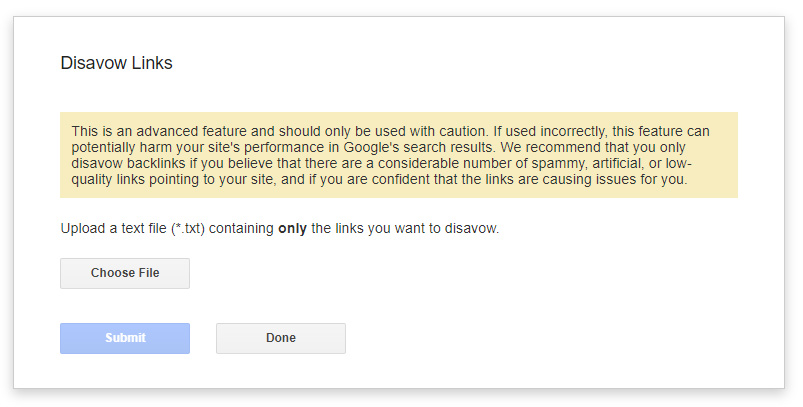
For Local SEO, there’s more to it, like keeping your directory listings up to date, managing your reviews, offering support to customers or clients who may be having issues and discussing it on forums and other places online, and anything happening elsewhere from your website.
Local SEO Optimization:
Now that we’ve got the basics of any SEO audit out of the way, let’s start to optimize for local.
You’ve got a strong foundation by now, and you’ve ensured that there won’t be anything holding you back. That doesn’t mean you’ll just instantly start ranking, but at least you’ll be running on pavement instead of through the sand.
Building Back Links for Local SEO
It’s good to get links from other sites that cater to your same local region. For people who have become blind to typical, broad guest post outreach emails, you have an advantage in being local for your outreach. It’s not some random person on the other side of the internet reaching out, it’s a neighbor.
Here are some ideas to get you started:

- Local newspapers and zines are going to be a lot easier to get in touch with when you have something newsworthy to share compared to national outlets and getting that first bit of exposure can snowball in the right circumstances
- Offering discounts to teachers could earn you a nice link on a strong .edu site or the website of the local teacher’s union or organization. The same applies to offering military discounts, deals for firefighters, and any other groups in your community. Keep an eye out in your day to day life, there are plenty of opportunities.
- You can sponsor local sports teams or leagues, if they have a website where they list their sponsors you can simply ask them what it would take to get listed there. On that same note, you can also find local charities that you appreciate, and reach out to them for sponsorship opportunities.
- Tourism Boards in cities that operate blogs are often on the lookout for locally-relevant content, so consider creating some useful resources for your city like “14 fun things you can do for free in [city]”, or “9 historical [city] places you’ve got to visit”, or “13 hidden gems in [city] that most locals don’t know about”.
- There’s probably no shortage of bloggers where you live, whether they cover local restaurants, arts and culture, fashion, whatever. Depending on your business and if it’s a good fit, you could invite them to stop by or offer them your products or services.
- Other local businesses can prove to be very useful, too. Leverage existing relationships, reach out to other local companies with websites along with any relevant chambers of commerce.
Scoping out the Competition
Before you can crush your competition, you’ve got to identify them. This also gives you a chance to see where their traffic is coming from.

It’s not as simple as just typing your keyword into the search engine and looking at the top few results because you’re going to leave a lot of stones turned with that strategy.
While it’s good to know who is currently ranking at the top and how they got there, you’ve also got to know who is on the rise. SERPWoo allows you to see up to 100 different sites for each of your keywords.

Some SERPs are going to look downright chaotic, while others will be more consistent over time. You’ll notice that a lot of them seem to settle down as you get into the top few positions, where it’s less common for sites to appear out of nowhere or drop off the map. When you notice new sites creeping towards the top and staying there, pay extra close attention to them.
You’ll want to enter a geographic location when creating your new project in SERPWoo:
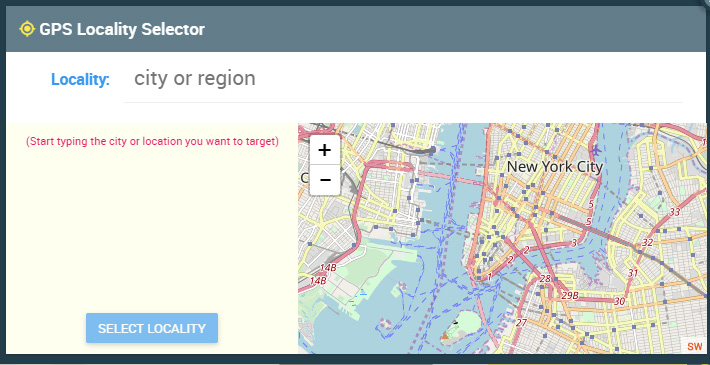
Check out the back link profiles of any competitors that are ranking for the keywords you want to target locally. Take note of any local directories or other places they’ve gotten links that seem obtainable. They could very well be ranking in low competition areas with low-quality spammy links or very few links at all, in which case you shouldn’t have a hard time dethroning them.
Once you’ve got a list of local competitors, you can run them through something like Ahrefs’ Content Gap tool, which will give you a list of keywords that your competitors are ranking for that you are not ranking for.
Building Citations for Physical Locations / NAP
NAP stands for name, address, and phone number and we’ve mentioned it a handful of times so far, and now we’re going to dig in deeper because this is a key aspect of Local SEO.

Citations are a way to get your business information out there.
There are platforms that allow for hidden addresses, and others that will require you to display your address. For a physical retail location, you'll want to include the address in your citations so that it's easy to find for people who are searching you.
For home-based businesses or businesses where you don't need customers to come to you, you may opt to keep your address private. This will hinder you in building citations and make it a much harder to secure your positions locally.
Manually or Automated?
You can go and create these citations by yourself by hand, spend an hour here and an hour there and you'll be all set. It doesn't take long to do each one, but it starts to add up if this is something you're doing for clients.

Doing this manually means you can add an extra level of care, take the time to write amazing descriptions that fit each platform, and avoid any lower-quality sites that aren't a great fit. When you opt for the automated route, you just might not get that same level of care. Ideally, the expertise and experience of the people building the citations will help make up for that.
There are services that will do it for you automatically, but at the very least you'll want to vet them and check out the citations they're building to ensure that everything looks good. You definitely don't want to wake up and see that there are 800 citations for your business, but they say you're open on Monday when that's your only day off.
Staying Organized
You'll want to keep track of all of your business listings and citations, because if your information changes down the road, you'll have to go back and update it. When people are making local searches, they're often ready to spend money, so if they can't find you or are seeing outdated information, that's a serious issue.

The Power of Reviews
Even thought people are getting more savvy online and starting to become more aware that there are a lot of fake reviews out there, it's still one of the most powerful tools for social proof and doesn't just help with conversations but can also help you rank higher in local listings.
It can be a rough terrain to navigate since the vast majority of your customers won't feel strongly enough either way to leave a review.

It's often the people who have an issue or a problem that will leave a review, and often out of frustration, so reviews tend to skew negative in that sense either way.
People who have over-the-moon positive experiences will often be more motivated than average to leave a review, too.
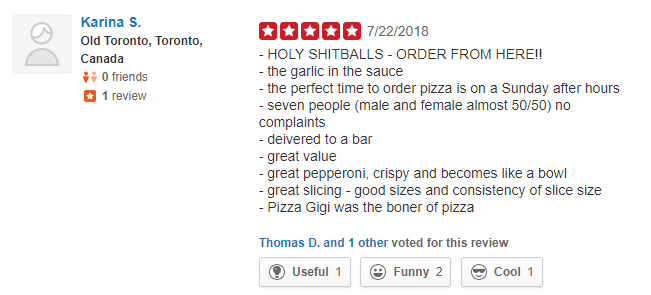
There are many ways you can encourage people to leave you reviews for your business, but make sure it's not against the rules of whichever platform you're using to flat out ask for reviews (Or if it is, understand the risks and go for it!).
As an alternative, you can put up signs saying that your business is featured on certain platforms, letting your customers know they could leave a review without directly asking for it. As we looked at earlier, Yelp uses some pretty strong language to discourage you from asking for reviews, but they have no way of knowing what you say to your customers or clients.
Some people will include links to their preferred review platforms in their email signatures, website footers, and posted up in their physical locations. Facebook pages for businesses allow customers to leave star reviews, as do services like Yelp, Google My Business, and more.
HubSpot has put together a helpful list of sites that collect customer reviews, and can also be great for building citations.
What About Testimonials?
Google has stated in the past that they would prefer you don't markup customer testimonials hosted on your own site with Schema.
John Mueller, the Webmaster Trends Analyst at Google, said the following in response to a user who needed help setting up Schema for reviews on a testimonials page:
"I'd just like to add that testimonials are not reviews, and that it generally doesn't make sense to use reviews like this for a company's website. My recommendation would be to remove that markup."
Positive testimonials are still important to have on your site, but as far as giving out scores, Google says they want you to leave that up to other platforms.

Fixing Negative Reviews
There are different ways to look at negative reviews. You might get annoyed at first and feel the urge to respond in a snippy way. Take a minute, breathe, don't take the negative review too personally, and don't respond while you're still heated.
Not everybody got the memo:
You can do real harm to your reputation if you get into the habit of clapping back at bad reviews, and it will even encourage some people to mess with you just to get a reaction. It's a bad cycle to get into.
You've got to realize that bad reviews are just a part of doing business, you're always going to run into someone who misunderstands what you offer and thus has a bad experience from having faulty expectations, or is just having a rough day and needs to take it out on someone, or who just genuinely had a bad experience and wants to share that so that you can do better.

Before you reply to any negative reviews, remember that your response is public and use it as an opportunity to put your best foot forward. You can offer to make the situation right, and you can explain what went wrong and why it won't happen again.
Some customers will be open to giving it another shot, accepting your proposals to fix the situation, and ideally will take a few moments to update their review as well.
If the reviews are clearly being posted by a competitor to lower your score, you can report them to whichever platform is hosting the reviews. Red flags to look for are accounts that were just created recently to leave the review and that have only left the one review, aren't active users, and aren't people that you recall doing business with. In some more serious cases, legal action may be necessary.
Google My Business
Google My Business is how Google helps you manage info about your business and how it is presented to people who are searching locally for your business, or businesses like yours.
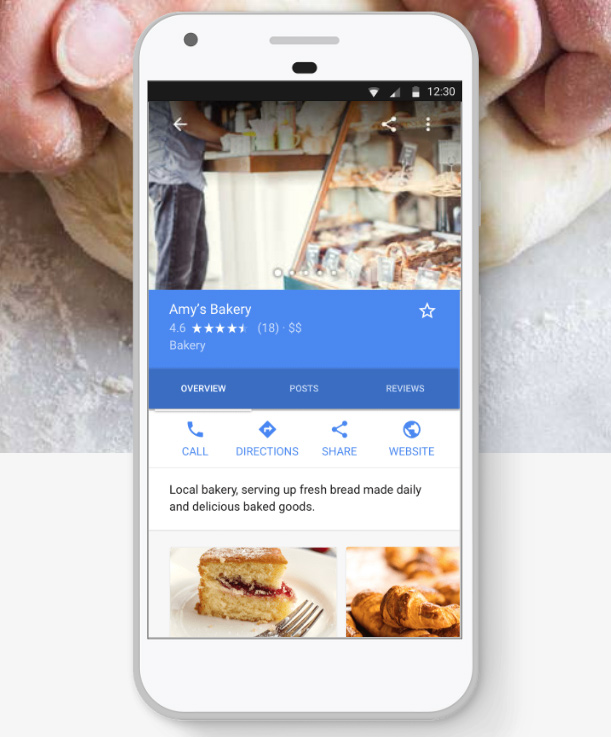
For instance, if you're a carpenter and somebody is searching for a carpenter in your city, and you've got good local SEO and everything set up nicely in Google My Business, then you may show up even though they didn't search specifically for your business' name.
According to Moz, Google My Business accounts for 19% of ranking factors for the local pack. Next up is links at 17%, on-page factors at 14%, citations and reviews both at 13% each, behavioral signals like CTR and personalization are both at 10% each, and finally social signals rounds it out at 4%. (source)
This differs from typical organic results where link signals are the top factor with 29%, and things like reviews and citations fall near the bottom of the list instead of near the top.
In any case, Google My Business is something you’ll want to setup, and here’s how:
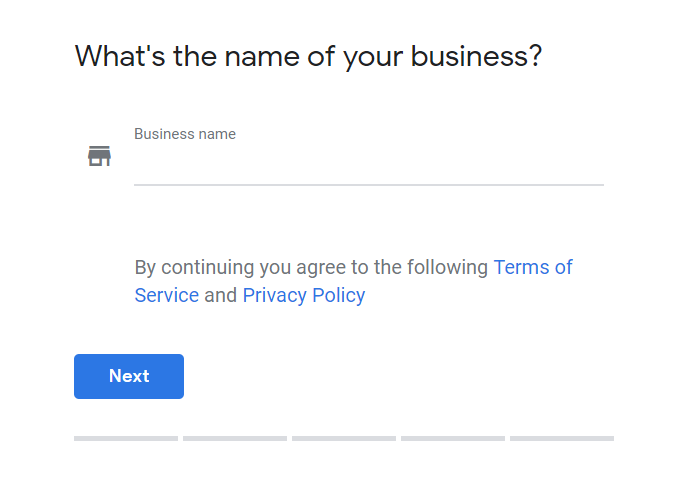
- Visit Google My Business and click “START NOW”.
- Next, enter the name of your business and click next.
- Enter which category best describes your business.
- Fill out the rest of the information including address and contact info.
- You may be required to verify your business by being sent a code in the mail.
It’s a very straightforward process to get this setup and gets your foot in the door for local
rankings.
Common Mistakes to Avoid
If you’ve made it this far, you’ll have most of these things covered already, but it doesn’t hurt to have a refresher and we’ll also be mentioning a few things that didn’t fit elsewhere in this guide to local SEO.

1. Avoid Duplicates
Even if certain things change about your business, it’s a bad practice to create multiple listings on the same platforms.
Moz has a quick little tool that can help you check the quality of your local listings. This leads to a paid service, but you can get a rough outline without paying. You may have duplicates if you’ve hired multiple companies to help with your SEO at various points, or created them yourself, sometimes years later without realizing.
In any case, this can be confusing to search engines and your customers, especially if there is contradictory information.
2. Don’t Keyword-Stuff
Even though certain aspects of Local SEO are a throwback to SEO of yesteryear, it’s still not a good idea over-optimize or just to shovel keywords in anywhere you can.
If your business is called “Tom’s Shoe Shop”, don’t enter your business name in your listings as “Tom’s Shoe Shop Buy Cheap Jordans Online Shoe Sales Designer Shoes”.
There are places you can sneak your keywords in like the description and specialty areas, and they’ll also start to show up naturally in reviews, depending on the platform.
3. Faking It
When people found out that Local Packs were based on proximity, you can bet they started signing up with address all around their city.
If you don’t have multiple real locations, be very careful trying to game the system here because if you get busted, you’ll be out of luck.
4. Don’t Ignore Negative Reviews
It can be stressful to see a negative review about your business, but it’s typically not a good idea to just ignore it.
You’ll usually have an opportunity to respond to it, and it’s best to do that when you’re calm and relaxed. Focus on what went wrong, really demonstrate that you’re listening and let them know what you’ve already changed or will be changing to prevent this from happening again.
It can be very enduring to see a business owner calming and respectfully replying to a negative review.
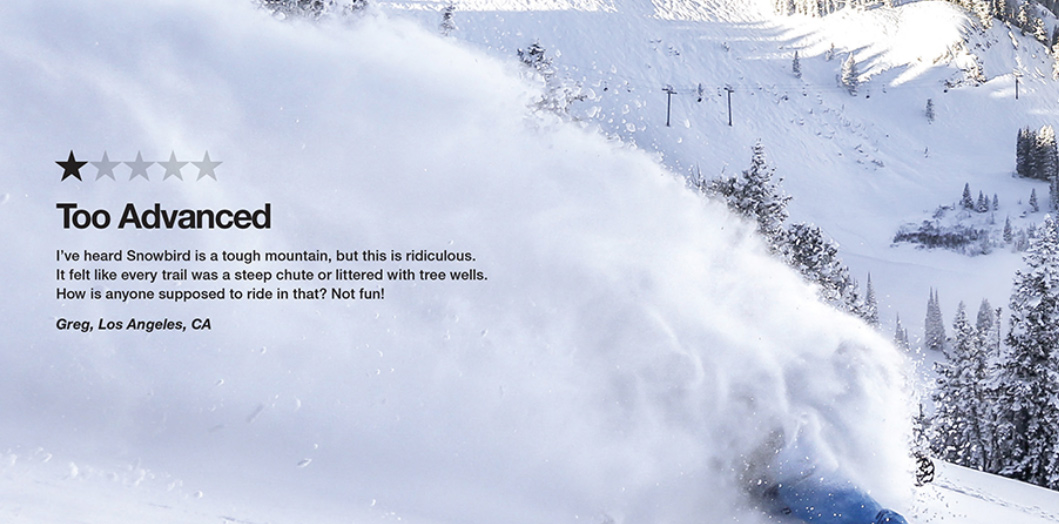
Or do a lodge called Snowbird did, and use the negative review as a selling point for the difficulty of their ski slopes.
You don’t have to be a PR genius, just don’t be rude, and don’t ignore them. You might not be able to get rid of them, but adding a little context or even just handling it nicely can really soften the blow.
5. Encourage New Reviews
Some businesses will make a push to get reviews online, and then start to coast. Customers want to see more recent reviews, so this is something you should always be thinking about.
Those freshness factors also provide strong signals to search engines that your business is still booming and serving happy customer after happy customer.
6. Categories Are Important
Here’s a little guide Google has about selecting your category if you run into any hiccups, like if there isn’t a perfect match for your business.
7. Being Consistent with Your NAPs
Just like Garfield the Cat, you’ve got to be consistent with your naps.

For minimal resistance, try to write your address identically same each time. If your Google My Business listing says “453 Saint John’s Parkway Suite 4”, don’t write it as “4-453 St. John’s Pkwy.” Google is pretty clever, but any discrepancies between listings just adds more room for error and confusion.
8. Don’t Forget About Traditional SEO
If all of your focus is on the local-specific factors, you’ll be missing out on a good chunk of your site’s ranking potential. Also, having organic rankings can give you buffer against any future increases in competition in the Local Packs, or even major changes to them.
9. Local SEO Markup
Here is Schema markup for a local business by Matthew Barby c/o Neil Patel’s blog:
<div itemscope itemtype="http://schema.org/LocalBusiness">
<p itemprop="name">COMPANY NAME</p>
<p itemprop="address" itemscope itemtype="http://schema.org/PostalAddress">
<p itemprop="streetAddress">ADDRESS LINE 1</p>
<p itemprop="addressLocality">CITY</p>,
<p itemprop="addressRegion">REGION</p>
<p itemprop="postalCode">POSTCODE/ZIP</p>
<p itemprop="telephone">PHONE NUMBER</p>
<meta itemprop="latitude" content="LATITUDE">
<meta itemprop="longitude" content="LONGITUDE">
</div>
Measuring your Results
You’ve probably heard the rumors that SERPWoo is the best way to track your rankings in the SERPs, but did you know about our Local SEO features?
You can track your rankings based on location-specific SERPS, using pinpoint accurate GPS data.
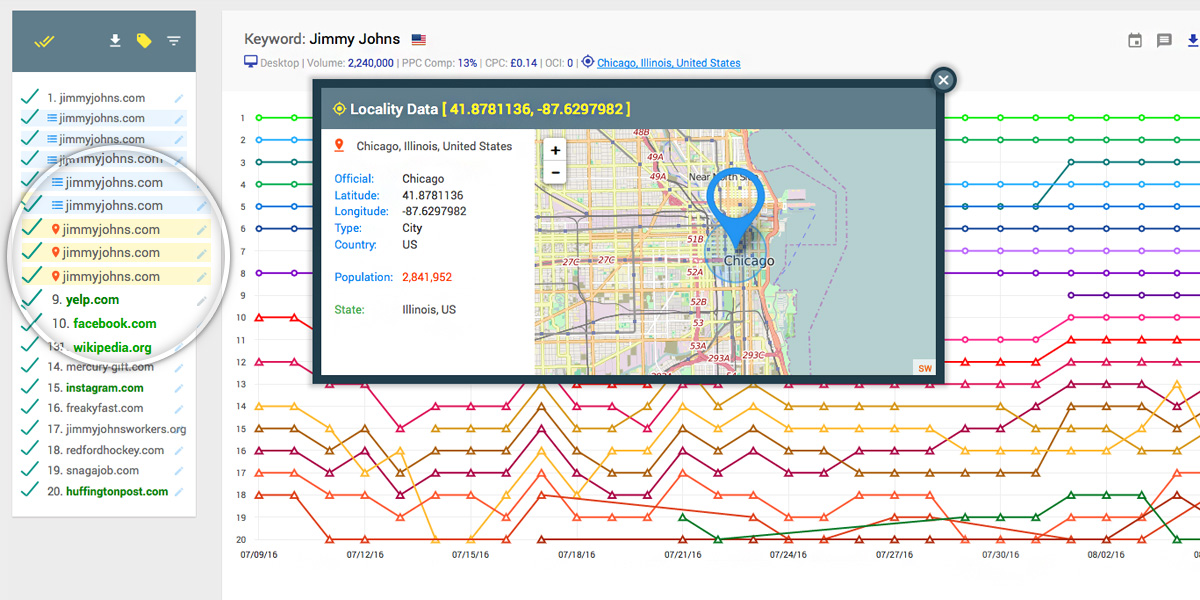
This comes in useful when trying to identify your competitors. You can also identify businesses in similar fields that rank, but aren’t local to you, thus creating an opportunity to swap links without linking directly to a local competitor.
Conclusion
Local SEO really isn’t all that difficult when you break it down, it’s straight forward. Get your citations setup, get your site running smoothly with solid content, and build some links.
That doesn’t mean there isn’t room for massive creativity, and you’ll see plenty examples of that as you start to dig around.
Many SEO professionals have been putting more and more of an emphasis on local SEO, even in places that aren’t local to them, due to the decreased levels of completion compared to battling it out on a national level. Don’t be surprised to see more and more SERPs become localized.
Want to get a downloadable cheatsheet of steps you should take to shape up your ( or your client's ) local seo? Just click here.
